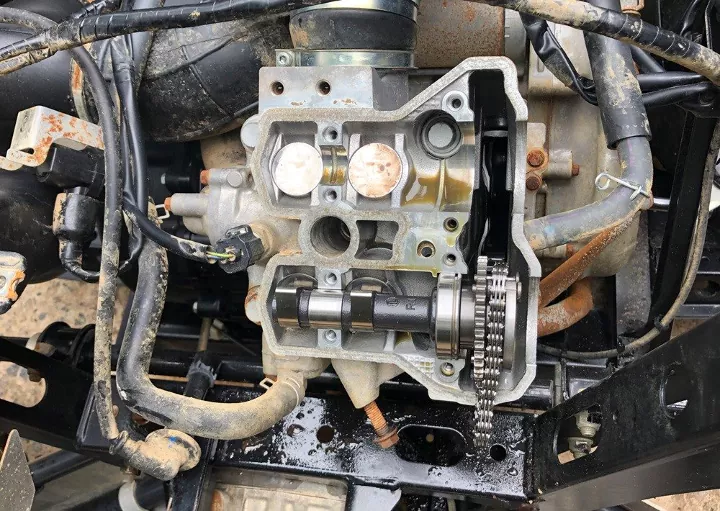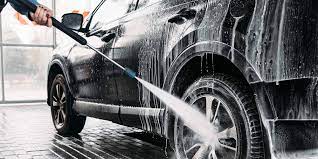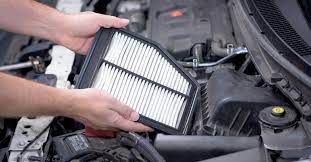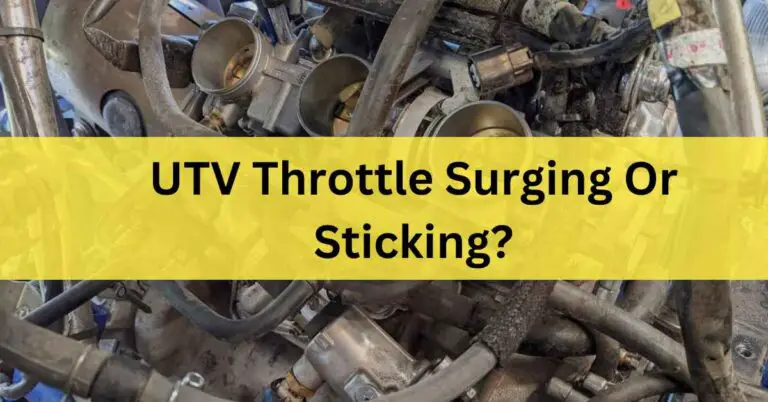UTV how to get dried mud off exhaust? Tips & Precautions In 2024
The exhaust system is an important component of any vehicle, including UTVs. It removes harmful gasses from the engine and expels them into the atmosphere.
However, over time, the exhaust system can become clogged with dirt, debris, and other materials, which can lead to several problems.
To get dried mud off a UTV exhaust, gently scrub the area with a soft-bristled brush or cloth.
You can also use a degreaser or a mixture of warm water and dish soap to loosen and remove the mud. Avoid using abrasive materials or harsh chemicals that could damage the exhaust.
In this article, we will discuss the importance of keeping the UTV clean and how to get dried mud off the exhaust of a UTV.
Table of Contents
Why It Is Important to Keep the Exhaust Clean:
1. Maintain Optimal Performance:
One of the primary reasons why it is important to keep the exhaust clean is to maintain optimal performance.
A clogged exhaust system can cause several problems, including reduced power and decreased fuel efficiency.

When the exhaust system is clogged, it cannot expel exhaust gases as efficiently, which can cause the engine to work harder to compensate.
It can lead to decreased performance, lower fuel efficiency, and increased wear and tear on the engine.
2. Prevent Engine Damage:
A dirty or clogged exhaust system can also cause damage to the engine. When the exhaust system is clogged, heat can build up in the engine compartment, which can cause damage to engine components.

Additionally, a clogged exhaust system can cause back pressure, forcing exhaust gases into the engine.
It can cause damage to engine valves, pistons, and other components, leading to expensive repairs.
3. Improve Air Quality:
Another reason why it is important to keep the exhaust clean is to improve air quality. The exhaust system removes harmful gases from the engine and expels them into the atmosphere.
However, when the exhaust system is clogged, these harmful gases can be released into the environment, leading to air pollution.
Keeping the exhaust clean can help reduce harmful emissions and improve air quality.
4. Reduce Noise:
A clogged exhaust system can also cause excess noise. When the exhaust system is clogged, the engine must work harder to push exhaust gases through the system.
It can cause a loud, rumbling noise that can be heard inside and outside the vehicle. Keeping the exhaust clean can reduce excess noise and create a more pleasant driving experience.
How to Keep the Exhaust Clean?
Keeping the exhaust clean is a simple process that can be done with a few basic tools and materials. Here are some steps you can take to keep the exhaust clean:
1. Regularly clean your vehicle:
One of the simplest ways to keep your exhaust clean is by regularly washing your vehicle. It will help remove dirt, dust, and other debris that can accumulate on your exhaust pipe and muffler.

Use a mild detergent and warm water to clean your vehicle, and dry it thoroughly afterward.
2. Check for leaks:
Exhaust leaks can cause your vehicle to release harmful emissions, contributing to air pollution.
If you suspect an exhaust leak, take your vehicle to a mechanic to have it checked. In some cases, a leaky exhaust can be repaired, but in other cases, it may need to be replaced.
3. Avoid driving on rough terrain:
Driving on rough terrain can cause your exhaust to get bumped around, damaging or dislodging your muffler or exhaust pipe. Avoid driving on rough terrain whenever possible to help keep your exhaust in good condition.
4. Use high-quality fuel:
Using high-quality fuel can help keep your engine running smoothly, which can, in turn, help keep your exhaust clean.
High-quality fuel is typically more refined and contains fewer impurities than lower-quality fuel, which can help reduce the amount of carbon buildup in your engine and exhaust system.
5. Change your air filter regularly:
A dirty air filter can cause your engine to work harder, increasing fuel consumption and reducing power.
Additionally, a dirty air filter can cause your engine to produce more carbon emissions, contributing to air pollution.

Check your vehicle’s owner’s manual to determine how often you should change your air filter and follow the manufacturer’s recommendations.
6. Keep your engine well-maintained:
Regular maintenance of your engine can help keep your exhaust clean.
Be sure to follow the manufacturer’s recommended maintenance schedule, which may include changing the oil, checking the spark plugs, and replacing worn-out parts.
7. Use fuel additives:
Fuel additives can help keep your engine and exhaust clean by reducing the amount of carbon buildup in your engine and exhaust system.
These additives can also help improve fuel efficiency and reduce emissions. Be sure to choose a fuel additive compatible with your vehicle and follow the manufacturer’s instructions.
8. Drive efficiently:
Driving efficiently helps reduce the stress on your engine, which helps keep your exhaust clean.
Some tips for driving efficiently include accelerating slowly, maintaining a steady speed, avoiding excessive idling, and keeping your tires properly inflated.
9. Install a catalytic converter:
A catalytic converter is a device installed in your vehicle’s exhaust system and helps reduce the number of harmful emissions your vehicle produces.
If your vehicle does not already have a catalytic converter installed, consider having one installed to help keep your exhaust clean.
10. Consider upgrading your exhaust system:
If you want to improve your vehicle’s performance and keep your exhaust clean, consider upgrading your exhaust system.
A high-performance exhaust system can help reduce your engine’s backpressure, leading to improved performance and reduced emissions.

11. Use a Degreaser:
If you notice the exhaust system is dirty or clogged, you can use a degreaser to clean it. A degreaser is a cleaning solution designed to break down grease, oil, and other types of dirt.
Choosing a degreaser that is safe for use on exhaust systems is important, as some harsh chemicals can cause damage.
12. Scrub the Exhaust:
After applying the degreaser, you can use a soft-bristled brush to scrub the exhaust. Be sure to scrub gently, as a hard-bristled brush can scratch the surface of the exhaust and cause damage.
You may need to repeat this process several times to remove all dirt and debris from the exhaust.
13. Rinse and Dry:
Once you have scrubbed the exhaust, you can rinse it with water to remove any remaining dirt and debris.
After rinsing, dry the exhaust thoroughly with a clean, dry towel. It is important to use a soft towel, such as a microfiber towel, to avoid scratching the surface of the exhaust.
Materials Needed:
Before removing the mud from the exhaust, it is important to gather the necessary materials. These include:
- A hose or a pressure washer
- A bucket
- A soft-bristled brush
- Degreaser
- Water
- Microfiber towels
Steps to Remove Dried Mud from the Exhaust:
Here are the steps to remove the dried mud from the exhaust of a UTV:
Step 1: Let the Exhaust Cool Down:
Before starting the cleaning process, letting the exhaust cool down is important. The exhaust can become very hot while the UTV is running, and touching a hot exhaust can cause serious burns.
It is recommended to wait at least an hour before cleaning the exhaust to ensure it has cooled down completely.
Step 2: Rinse the Exhaust with Water:
Once the exhaust has cooled down, the first step is to rinse it with water. You can use a hose or a pressure washer for this.
The water will help to loosen up the mud, making it easier to remove. It is important to use moderate pressure when rinsing the exhaust to avoid damaging it.
Step 3: Apply Degreaser:
After rinsing the exhaust with water, the next step is to apply a degreaser. A degreaser is a cleaning solution designed to break down grease, oil, and other types of dirt.
There are many commercially available degreasers that you can use, or you can make a homemade solution using water and vinegar or baking soda.
Following the manufacturer’s instructions when using a commercial degreaser or mixing the homemade solution in the right proportions is important.
Step 4: Scrub the Exhaust with a Soft-Bristled Brush:
Once you have applied the degreaser, use a soft-bristled brush to scrub the exhaust gently. Be careful not to apply too much pressure, as this can scratch the surface of the exhaust.
Start at the top and work your way down, getting all the mud off. It is important to use a soft-bristled brush as a hard-bristled brush can scratch the surface of the exhaust and cause damage.
Step 5: Rinse with Water:
After scrubbing the exhaust with a brush, rinse it thoroughly with water. Make sure to remove all the degreaser and mud from the surface of the exhaust.
It is important to rinse the exhaust thoroughly, as any remaining degreaser can cause damage to the surface of the exhaust.
Step 6: Dry the Exhaust with Microfiber Towels:
Once you have rinsed the exhaust with water, use microfiber towels to dry it. Make sure to remove all the water from the surface of the exhaust, as any remaining water can cause rust and corrosion.
Microfiber towels are ideal for drying the exhaust as they are soft and absorbent and do not scratch the surface of the exhaust.
Additional Tips and Precautions:
Here are some additional tips and precautions to keep in mind when cleaning the exhaust of a UTV:
- Always wear protective gloves and eyewear when working with a degreaser or any other cleaning solution.
- Avoid using abrasive materials such as steel wool or harsh chemicals, as they can damage the exhaust system.
- Please do not use a high-pressure washer on the exhaust, as this can damage the surface of the exhaust and cause it to rust.
- If the mud is particularly stubborn, you can repeat the process of applying a degreaser and scrubbing until it is completely removed.
- Make sure to let the exhaust cool down completely before cleaning it, as a hot exhaust can cause serious burns.
If you are not comfortable cleaning the exhaust yourself, it is recommended to take the UTV to a professional mechanic or detailer who can clean it for you.
They will have the expertise and specialized tools needed to clean the exhaust without causing any damage.
Frequently Asked Questions:
1. What is a degreaser, and why is it used to clean the exhaust?
A degreaser is a cleaning solution designed to break down grease, oil, and other types of dirt. It is used to clean the exhaust because it helps to remove dried mud and other types of dirt from the surface of the exhaust.
2. What kind of brush should be used to scrub the exhaust?
A soft-bristled brush should be used to scrub the exhaust, as a hard-bristled brush can scratch the surface of the exhaust and cause damage.
3. Can a high-pressure washer be used to clean the exhaust?
No, a high-pressure washer should not be used to clean the exhaust, as this can damage the surface of the exhaust and cause it to rust.
4. What should be done if the mud is particularly stubborn?
If the mud is particularly stubborn, you can repeat the process of applying a degreaser and scrubbing until it is completely removed.
Conclusion:
Cleaning the exhaust of a UTV is an important part of maintaining its performance and longevity. It is a simple process that can be done easily with the right materials and precautions.
Following the steps outlined above and keeping these additional tips and precautions in mind, you can effectively remove dried mud from the exhaust and keep your UTV running smoothly for years.
Remember to wear protective gear, avoid harsh chemicals, and take your time to ensure a thorough cleaning.
Related Post:






